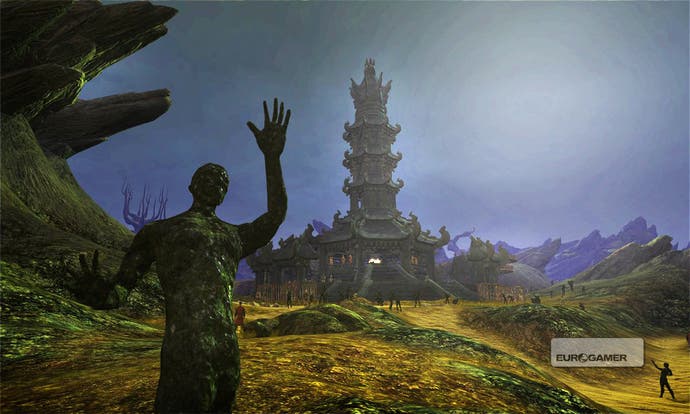Age of Conan: Rise of the Godslayer
Die another deity.
Age of Conan game director Craig Morrison is presenting the game's first expansion, Rise of the Godslayer, to the press in a darkened hotel suite in San Francisco, a stone's throw from the Game Developers Conference. He's got a neat slide summarising how Funcom's focus has shifted during the development of its MMO, from the three Cs of "combat, combat, combat" at launch to "combat, community, content" as it consolidated an initially shaky live game over the last 20-odd months. The mantra for the expansion, he finishes, is "combat, choice, consequence".
Neat, but a little disingenuous, because content - that C in such desperately short supply when the game launched in 2008 - is actually still firmly at the top of the agenda. The need to flesh out Conan rather than stretch it further has dictated the structure and style of this unusual expansion which, despite adding a huge new continent to the world map, doesn't raise the level cap. Nor does it add new classes or professions or player-versus-player systems, or generally get involved in the feature box-ticking that characterises the standard MMO add-on. It's just a lot more adventure and exploration for solo players and groups, presented in an interestingly organic fashion.
"The expansion is very specifically designed to address the content shortcomings that the game had when it launched," Morrison admits afterwards. "The expansion has really been about adding more and more content for players to play through."

You'll find most of the thinking and much of the detail behind Rise of the Godslayer in our original preview from Gamescom last summer. The headlines: the expansion opens up the visually striking, Asian-themed continent of Khitai, as well as the Khitan playable race; the questing - mostly for max-level players but also including some mid-level content - is largely based around sets of warring factions, who reward players' loyalty with armour sets; you'll be able to capture and train tigers and wolves as pets, combat companions and ultimately mounts; and instead of levelling, players will use both earned points and EVE-style offline skill training to make their way through an "alternate advancement" system.
The latter is what Funcom revealed least of last year, so it's the principal point of interest in this GDC presentation. Morrison shows the huge talent tree that will be available to a single character, broader than it is deep and studded with dozens of skills. These are divided in rough thirds into general abilities for all classes, abilities specific to the four character archetypes, and finally those specific to the twelve actual character classes.
Each skill has ranks, and you can choose to spend your points - or offline training time - on acquiring more skills or ranking up the ones you have, advancing or diversifying your character. Given the sheer breadth of skills available and the number shared between classes, it's an extremely free-form system, intended to reward players with flexibility as much as power. There's no cap as such, and since skill points might run out but the offline skill training never will, with enough time you'll be able to collect and rank up the entire set.





.png?width=291&height=164&fit=crop&quality=80&format=jpg&auto=webp)



